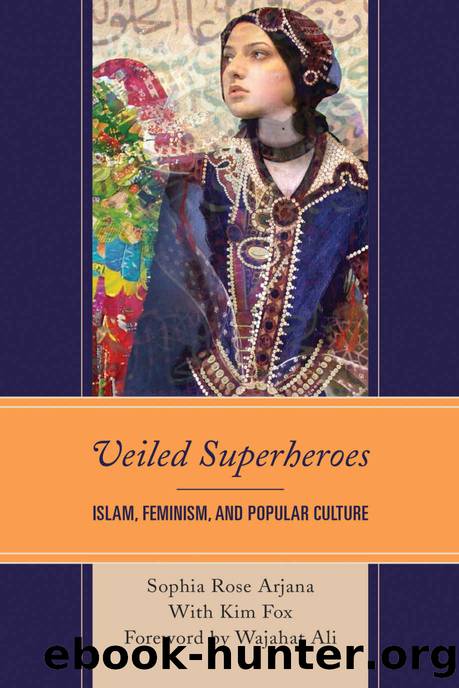Veiled Superheroes: Islam, Feminism, and Popular Culture by Sophia Rose Arjana

Author:Sophia Rose Arjana [Arjana, Sophia Rose]
Language: eng
Format: epub
Tags: Popular Culture, Religion, Islam, Feminism & Feminist Theory, Gender Studies, Women's Studies
ISBN: 9781498536530
Google: g-k5DwAAQBAJ
Amazon: B076G87PKP
Publisher: Lexington Books
Published: 2017-11-01T05:00:00+00:00
Chapter 4
Burka Avenger and the Subversive Veil
In 2010, the Pakistani pop music star Haroon began work on Burka Avenger, an animated childrenâs television series. The show features the schoolteacher Jiya and the adventures of her alter ego, Burka Avenger, a Muslimah superhero who wears a black ninja-like costume when she fights criminal elements like the Taliban. Burka Avenger is a powerful characterâvisually arresting and extremely entertaining. She is not simply a childrenâs character, but an icon of Pakistani and Islamic feminism. Burka Avenger does not resort to Western styles of dress or politics in her quest for liberation. Instead, she relies on her own religious and cultural foundations, which are strongly Islamic.
Burka Avenger is significant for several reasons. For one, it is a Pakistani production, not an imported series from Hollywood. Pakistan, like much of the world, has a large number of imported forms of entertainment from the United States, including some, like Cartoon Network, geared toward children. In the case of animated cartoons, Disney has a huge reach; their products are found all over the world. As one scholar has remarked, Disney has a history of featuring white characters in privileged positions. In Pocahontas (1995), even the title character is subjected to her white loverâs power. âThe exoticized body of Pocahontas tells us it is only through a white manâs fantasy about her that a woman of color can become a heroine and can have a romance with a white hero.â1Burka Avenger represents a departure from these sorts of productions, with a Muslimah superhero created by Muslims.
Burka Avenger is an animated series, and as such, it functions in a different way than a comic or other graphic narrative. As Darcy Orcutt has written,
Comics constitute âmultimodalâ texts, those necessitating and facilitating understanding through multiple approaches to meaning-making. While their sensory grounding is normally visual, comic narratives evoke such multi-sensory experiences.2
Animation is a medium that evokes many senses. In Pakistan, a country in which attempts are made to exclude women from public view through seclusion and enforced veiling, Burka Avenger is an effort to counter these practices. While girls and women are subjected to symbolic annihilation in public, this is challenged by the visibility of an enormously powerful Muslimah superhero. This is important because of the power the media has in society. âSymbolic annihilation in the media is of concern because it presents people with implied messages about what it means to be a member of a culturally valued group versus a member of a socially disenfranchised group (or âout groupâ).â3
Animation gives life to elements that would otherwise be on the page. The movement inherent in a show like Burka Avenger draws the audience into an imaginary world that looks alive. Cultivation theory argues that âmedia viewersâ perceptions of social reality will be shaped by extensive and cumulative exposure to media-provided messagesâ like those seen in animated childrenâs series, which are then used to âmake decisions about how they will behave in real-world settings and situations.â4Burka Avenger is intended to influence the beliefs of its viewershipâPakistani children and adultsâon issues of gender equity.
Download
This site does not store any files on its server. We only index and link to content provided by other sites. Please contact the content providers to delete copyright contents if any and email us, we'll remove relevant links or contents immediately.
| Coloring Books for Grown-Ups | Humor |
| Movies | Performing Arts |
| Pop Culture | Puzzles & Games |
| Radio | Sheet Music & Scores |
| Television | Trivia & Fun Facts |
Paper Towns by Green John(5026)
Spare by Prince Harry The Duke of Sussex(4999)
Machine Learning at Scale with H2O by Gregory Keys | David Whiting(3976)
Never by Ken Follett(3708)
Learning C# by Developing Games with Unity 2021 by Harrison Ferrone(3313)
Fairy Tale by Stephen King(3159)
The Man Who Died Twice by Richard Osman(2959)
Fantastic Beasts and Where to Find Them: Illustrated edition by J.K. Rowling & Newt Scamander(2950)
Reminders of Him: A Novel by Colleen Hoover(2866)
Will by Will Smith(2741)
0041152001443424520 .pdf by Unknown(2730)
How The Mind Works by Steven Pinker(2697)
Fantastic Beasts and Where to Find Them: The Original Screenplay by J. K. Rowling(2448)
Never Lie: An addictive psychological thriller by Freida McFadden(2284)
Rationality by Steven Pinker(2232)
The God delusion by Richard Dawkins(2224)
It Starts With Us (It Ends with Us #2) by Colleen Hoover(2154)
Borders by unknow(2147)
The Dawn of Everything: A New History of Humanity by David Graeber & David Wengrow(2087)
